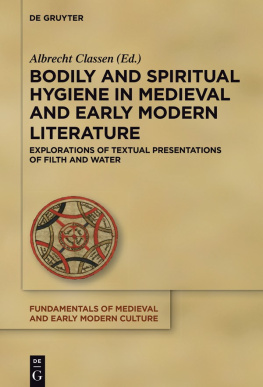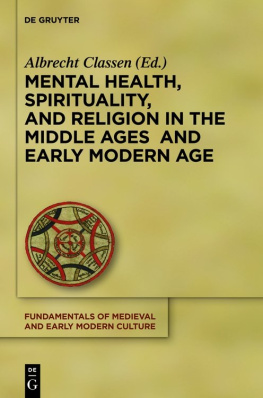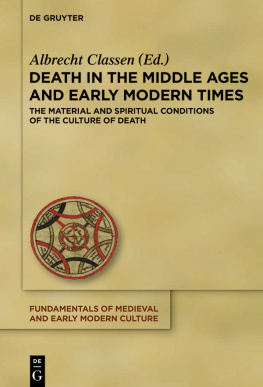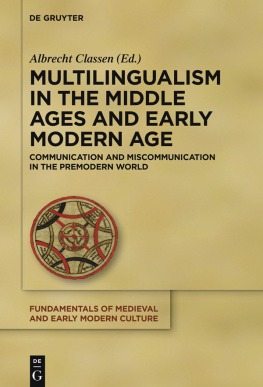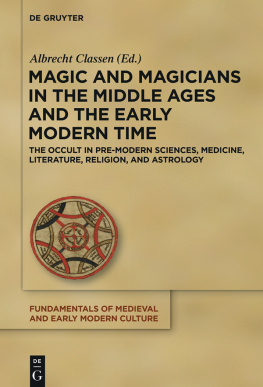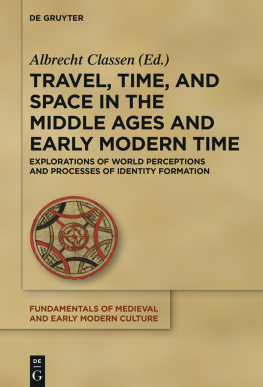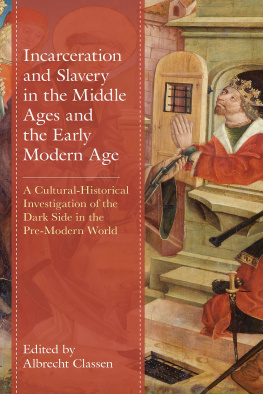Introduction: Bathing, Health Care, Medicine, and Water in the Middle Ages and Early Modern Age
Albrecht Classen , The University of Arizona, Tucson.
Modern Myths about Pre-Modern Hygiene
Unfortunately, modern, mostly negative myths about medieval and early modern conditions in the areas of hygiene, medicine, and health continue to dominate the popular understanding of the past. However, to formulate it bluntly, people in previous centuries might have used different approaches to hygiene and interpreted well-being perhaps differently than we do today, but they were neither dirty nor sickly, irrespective of high mortality rates, famines, epidemics, and perhaps underdeveloped medical care. Their societies worked well because they pursued their own hygiene and had, relatively speaking, a functioning medical system in place. but that is the same as today.
Unfortunately, we know relatively little about the daily practices of taking care of the bodily needs in the Middle Ages and the early modern age because we have fairly few documents, so it seems, addressing those issues, and because, which is probably much more accurate, modern research has not dealt with those issues to the same extent as it has done with regard to legal, religious, political, literary, art-historical, and military conditions, for instance. Again, however, this could also be said about the modern world in which only a minority of writers or artists turn their attention to such seemingly mundane aspects of everyday life, and do not include, unless driven by prurient interests, descriptions of bath scenes, not to speak of toilet matters.
Undoubtedly, today there is a whole industry in the Western world dedicated to baths, toilets, personal hygiene, and medical care, and there are many professions focused on those issues, but it would be erroneous to assume that in the past architects did not care about bathrooms, for instance, or that medical doctors ignored many of human healthcare needs, just because the records might not be specific enough. All monastic communities, for instance, had to have very clear organizational structures regarding bodily needs, including personal cleaning, defecation, health care, etc. Moreover, as we will see reflected in many contributions to this volume, water itself constituted a most meaningful element, both for drinking, cleaning, healing, and for spiritual transformations and epistemology.
The Core Issues: Dirt, Filth, and Health
To highlight the critical concern of the present volume, let me formulate up front the fundamental thesis pursued both here in this introductory essay and in the subsequent articles: Dirt and filth are not the central concern for most cultural historians, but if we ignore, for instance, the world of toilets and bathrooms, and then that of medicine and healthcare, we do not do full justice to the topic of medieval and pre-modern culture, and this both in concrete material terms and in a metaphorical, religious, and philosophical context. No medicine will be of long-term good if people did not take care of their bodies, either in the form of good and nourishing food, or in the form of hygiene. Hence the contributors to this volume address a variety of sub-themes pertaining to human well-being, but as diverse as the topics might be at times, they all add up to create a complex image of the fundamental living conditions in the pre-modern world.
The contributions are concerned with reflections on and concepts of filth, water, and hygiene in medieval and early modern texts, both literary, historical, and legal. Even if the emphasis rests on the question how the literary or legal material and other textual genres contribute evidence concerning such matters as health conditions, well-being, and medicine in the pre-modern world, the volume addresses both the cultural-historical and literary dimension. We also would have to consult art-historical sources, which was unfortunately not possible here.
Historians of medicine have already done their fair share of research, but their expertise has not necessarily carried over to the many different disciplines in Medieval and Early Modern Studies. Our collective efforts will hence be focused on hygienic, medical, and physiological aspects as reflected in literary, didactic, religious texts, but then also in medical treatises. The interest will rest on bathing cultures throughout time, on spas, on general health care, and on the medical We can safely assume that a solid understanding of pre-modern hygiene and medicine, for instance, as reflected both in the relevant healthcare regimens and literary documents, will contribute to a deepening of our awareness about the fundamental living conditions and the corresponding discourse in fictional and factual texts in that world. In other words, this book addresses both the medical/hygienic aspect and its correspondence in the contemporary literature.
Dirt as an Epistemological Challenge
Of course, dirt matters because it is just part of all life and simply has to be taken into account as a natural component of all existence. This also applies to health, medical problems, surgeries, hospitalization, and general cleanliness. We can, in other words, gain tremendous insight into the fundamental aspects of medieval and early modern culture, that is, peoples everyday lives, by studying, as the title of this book signals, hygiene, medicine, and well-being. By asking, once again, how people in the pre-modern era approached dirt, health, illness, well-being, medicine, and hygiene, we enter, only seemingly, a hidden level of all human existence. In reality, the discussion of these fundamental topics opens crucial perspectives toward the central cultural components because without health no one can exist, or exist well.
The human body cannot and must not be ignored, especially not within a cultural-historical context. As Mary Douglas pointed out, our ideas of dirt also express symbolic systems and the difference between pollution behaviour in one part of the world and another is only a matter of detail.
Human waste is as much telling as human art, it simply represents the other side of the same coin. The decrepit, sick, suffering, smelly, and disgusting body belongs as much to our existence as the well-dressed, healthy, strong, and pleasantly smelling body of an ordinary individual, which medieval artists have expressed numerous times within the framework of the memento mori motif, such as the painting Bridal Pair in the Cleveland Museum of Art and in the Muse de lOeuvre Notre Dame in Strasbourg, along with the back panel painting Standing Rotting Couple, all of them making up the double macabre portrait. But here we are not dealing with the motif of death, but with the question how pre-modern individuals approached hygiene, how much they resorted to baths and used water for cleaning, what role medicine played, and what constituted human happiness in the first place. In short, both hygiene and medicine have a very long history, and they shed as much, if not even more, light on cultural history as war chronicles, political narratives, Arthurian romances, etc.

